Finding Aid
Aldrich Collection
The New Bedford Whaling Museum’s Aldrich Collection of photographs consists of 258 images captured by journalist Herbert L. Aldrich (1860-1948) during the 1887 Arctic whaling season. Aldrich spent time on eight New Bedford whaling vessels between March and October of 1887, documenting the whaling industry and the native peoples of the Arctic.
Herbert L. Aldrich spent only eight months aboard whaling ships and 87 days in the Arctic Ocean, but his photographs and subsequent writings provide important documentation of the Arctic whale hunt and the Masinker and Nakooruk peoples. Photographs in the collection capture all aspects of the whale hunt and processing, the landscape of Alaska and Siberia, and the culture and customs of native peoples.
Aldrich resolved to accompany the Arctic whaling fleet after he was diagnosed with tuberculosis and told he had less than a year to live. At the time, he was a 27-year-old reporter for the New Bedford Evening Standard. Aldrich sought and received the support of leaders of New Bedford’s whaling industry, who wanted the journalist to document what they knew to be a dying industry. Aldrich sailed from San Francisco aboard the bark Young Phoenix (sometimes called the Young Phenix) on March 3, 1887. During the course of his journey, Aldrich was a passenger aboard the bark Eliza, the bark Hunter, the steam bark Balaena, the steam bark Lucretia, the steam bark Beluga, and the steam bark Thrasher, finally returning to San Francisco on October 25, 1887 aboard the steam bark Orca. These vessels were among the 32 New Bedford and San Francisco whalers that cruised in the Arctic Ocean during the 1887 season. This year was remarkably successful: it was one of the few during which no vessels were lost and the 600,000 pounds of baleen it produced was the largest single-year total taken by Arctic voyages between 1872 and 1909.
Aldrich had with him two Scovill detective cameras. He developed and printed photos aboard ship using primarily film negatives. It is estimated that Aldrich took over 700 photos during the season. Upon his return, Aldrich wrote and lectured extensively on his experiences in the Arctic. In 1889, Arctic Alaska and Siberia, or, Eight Months with the Arctic Whalemen was published by Rand, McNally and Company. In 1937, an abridged version of this text was published. Excerpts of the texts were also included in a variety of popular and trade magazines.
Aldrich went on to become managing editor of the Cleveland Plain Dealer and the Jacksonville Florida Citizen. He founded the Aldrich Publishing Company of New York in 1897 and published engineering books and magazines including Marine Engineering and The Boiler Maker. He was a member of the Society of Naval Architects and Marine Engineers, the Explorers’ Club, and the Whalemen’s Club of New Bedford. Although Aldrich did not live in New Bedford after 1897, he frequently visited the city and was a strong supporter of efforts to save the Charles W. Morgan. Upon Aldrich’s death in March 1948, many of the photographs and other artifacts of his Arctic travels were donated to the New Bedford Free Public Library.
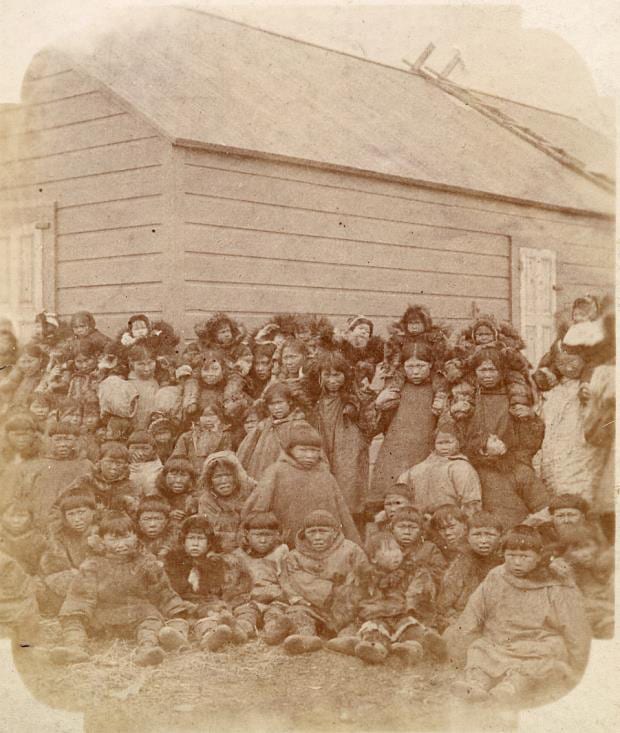
Search the online database for images in the collection. Click on SEARCH PHOTOGRAPHS, then SEARCH. On the top of the page, type “Aldrich” in the KEYWORD FIELD.
Finding Aid
Bodfish Collection
The New Bedford Whaling Museum’s Bodfish Collection consists of 111 photographs taken by master whaler Hartson H. Bodfish (ca. 1862-1945) during his time aboard the Beluga as captain and later the Mary D. Hume as first mate. During the long stretches of voyaging in the Arctic, Bodfish took many photographs documenting life aboard these ships and on the icy tundra as well as demonstrating the whale craft and hunting that took place.
Hartson H. Bodfish was the quintessential, hardworking, Yankee whaler. Throughout his Arctic voyages, he not only hunted and trapped but also documented his and many others’ lives through writing and by use of the camera. The result of this collection is an array of photographs displaying varied localities of the Arctic and North American landscapes, everyday Arctic living, the whaling industry, numerous Alaskan natives and other Americans.
In his journal, Bodfish often noted that the work aboard and off the ship was arduous, tiring, and wholly unsuccessful. While exceedingly strong-willed and steadfast, the years away from home took a toll on all Arctic crew members who longed for news from America. As cabin fever took hold, many whalemen, including those from the Mary D. Hume, either tried to or was successful with committing suicide.
Especially aboard the Hume, their journey seemed bleak and endless without a whale catch. It wasn’t until the late summer of 1891 when luck broke on the bow of the Hume and whales were hunted easily by the dozens. When she reached port on September 30th, 1892, the Mary D. Hume had profited $400,000 (equivalent to four million dollars in 1892) and was deemed the most profitable expedition in all whaling history.
While Bodfish’s time aboard the Mary D. Hume is likely to be the most notable, as captain of the Beluga he made many lucrative trips to the Arctic. In one such excursion in 1901, Bodfish bought two Musk Oxen from a native. Because the natives could slaughter these animals for profit, finding two young calves alive was a rarity. Although one was accidentally killed by dogs on the trip back, the other, called “Oliver Jones”, was brought to San Francisco and sold to the Bronx Zoo. Consequently, it was the first Musk Ox ever brought to America.
In all, Hartson H. Bodfish was not only a whaler, but also a pioneer of the Arctic territory, paving the way for countless American ships to rig out for winter in the icy North and the mysterious “Forbidden Sea”. His varied and expansive trips led Captain Bodfish to write a book entitled Chasing the Bowhead, 1936, in which he recounts his seafaring endeavors living and hunting in the Arctic, as well as his life before whaling.
Related Materials
Manuscript Collections
Mss 17: Hartson Hartlett Bodfish Papers
Books
Chasing the Bowhead: the autobiography of Hartson Bodfish
Digitized Logbooks
ODHS 948A: Grampus (Steam barkentine), 1888
ODHS 948B: Grampus (Steam barkentine), 1889
ODHS 949: Mary D. Hume (Steam brigantine), 1890
ODHS 950: Newport (Bark), 1892 – 1898
ODHS 951A: Beluga (Steam bark), 1897 – 1899
ODHS 952A: Beluga (Steam bark), 1900 – 1901
ODHS 953: Beluga (Steam bark), 1902
ODHS 954: Beluga (Steam bark), 1903
ODHS 955: William Baylies (Steam bark), 1905
ODHS 956A: William Baylies (Steam bark), 1906
ODHS 956B: William Baylies (Steam bark), 1907
ODHS 958: Herman (Steam bark), 1910
ODHS 959: Herman (Steam bark), 1911
For additional logbooks and journals related to Hartson H. Bodfish, please consult the Museum’s logbook and journal database.
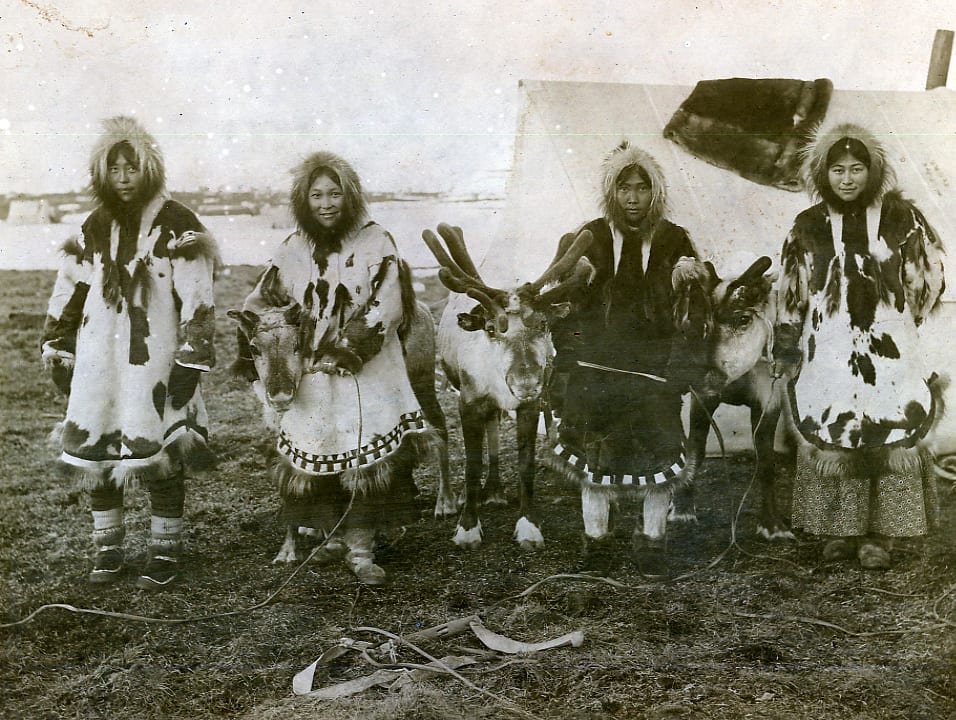
Search the online database for images in the collection. Click on SEARCH PHOTOGRAPHS, then SEARCH. On the top of the page, type “Bodfish” in the KEYWORD FIELD.
Finding Aid
Comer Collection
The Comer Collection of the New Bedford Whaling Museum consists of approximately 200 photographs taken by Captain George Comer (1858-1937) during whaling voyages to the Hudson Bay between 1900 and 1905. The majority of the photographs document Aivilingmiut and Qaernermiut culture; other subjects include the whaling schooner Era and her crew, whale processing, and the flora and fauna of the Hudson Bay.
George Comer made 14 Arctic voyages between 1875 and 1919. While his primary task during these expeditions was to hunt whales and seals and trade with the natives of the Hudson Bay, Comer had a deep interest in documenting the culture and customs of the people he encountered. Comer’s photographs, journals, and sound recordings, along with extensive collections of artifacts he made at the request of the American Museum of Natural History, provide important ethnographic documentation of the peoples of the Hudson Bay.
George Comer was born in Quebec in 1858 and moved to Connecticut as a child. In 1875, he made his first whaling voyage on the New London bark Nile. Twenty years later, Comer was made master of the New Bedford whaling schooner Era, on which he sailed until 1905. From 1907 until 1912, when he made his last whaling voyage, Comer was master of the Stamford, Connecticut whaling schooner A. T. Gifford. Comer was a financially successful whaler and trader, but his documentation of native culture has a much greater lasting value.
Comer first took photographs in the Arctic in 1893, but the vast majority of surviving photos was taken after 1900. Images in the Comer Collection date from 1900 to 1905, when Comer was master of the Era. In 1897, Comer became acquainted with Franz Boas, now considered to be the father of modern American anthropology. Boas taught Comer how to collect and document information on the native peoples; this knowledge is reflected in Comer’s photographs. Unlike most other whalers who photographed native peoples, Comer consciously tried to preserve the context of the customs, objects, and people he photographed. Although he took many photos in a “studio” on board the Era, he did not pose individuals using tools or behaving in ways foreign to their traditions.
In addition to taking photographs, Comer took copious notes on his experiences, the peoples with whom he interacted, and the natural history of the Hudson Bay. In 1984, Comer’s journal from the 1903-1905 voyage was published as An Arctic Whaling Diary, edited by W. Gillies Ross. Comer was commissioned by the American Natural History Museum to collect artifacts from the Hudson Bay region. He made plaster cast “life masks” of the faces and hands of natives and used a graphophone to record their songs and stories. Comer also conducted surveys and created charts of previously unmapped areas. After Comer’s whaling career ended, he continued sailing, both as a member of the U.S. Navy and a member of Arctic exploring expeditions. He served as a representative in the Connecticut legislature before his death on April 27, 1937.
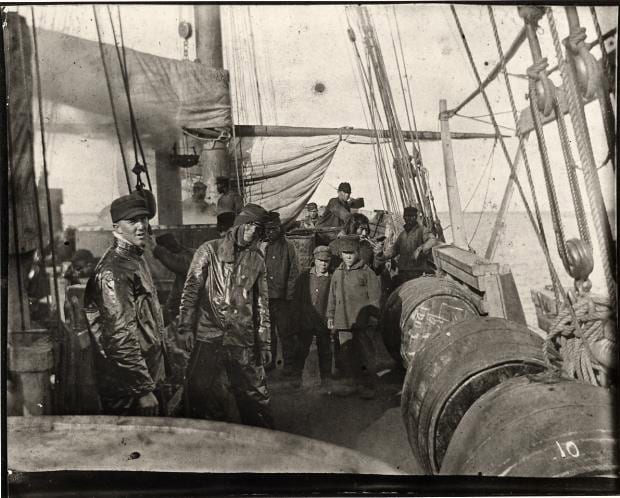
Search the online database for images in the collection. Click on SEARCH PHOTOGRAPHS, then SEARCH. On the top of the page, type “Comer” in the KEYWORD FIELD.
Finding Aid
Jarvis Collection
The New Bedford Whaling Museum’s Jarvis Collection consists of 127 photographs related to the life and career of David Henry Jarvis (1852-1911). Jarvis likely took the majority of the photos while serving in the U.S. Revenue Cutter Service in Alaska and the Bering Sea. The photos show the Revenue Cutter Bear, on which Jarvis served as a lieutenant and captain, whaleships the Bear encountered while in the Arctic, scenes of native peoples, landscapes, and documentation of the famous 1897-1898 rescue of eight whaleships.
The career of David Henry Jarvis is well-documented, due in large part to his activities during the winter of 1897-1898. None of this documentation refers to Jarvis’ photography; however, the content of the photos leaves little doubt that anyone but Jarvis took the photos. The majority of photos in the collection were once assembled in an album.
Jarvis was born in Berlin, Maryland in August 1852. He was appointed to the Revenue Cutter Service, one of three federal departments that would later be combined into the U.S. Coast Guard, in 1881. Jarvis served the majority of his career in Alaska and the Bering Sea. In 1897, while First Lieutenant aboard the Revenue Cutter Bear, Jarvis was appointed to lead a three-man expedition to rescue the crews of eight whaleships trapped in the ice at Point Barrow, Alaska. The ships were running low on food and the Bear could go no farther north than Cape Vancouver. Jarvis, Second Lieutenant Ellsworth P. Bertholf, and Doctor J. S. Call of the U.S. Public Health Service drove a herd of reindeer 1500 miles over the course of three months, arriving in Point Barrow on March 29, 1898 and saving 265 men from starvation.
Jarvis, Ellsworth, and Call were awarded the Congressional Gold Medal in 1902 for their rescue efforts. Jarvis later became captain of the Bear and served in the Revenue Cutter Service until 1905. He died in Seattle, Washington on June 23, 1911. In 1971, a Coast Guard cutter was named the Jarvis in honor of David Henry Jarvis. The Coast Guard also bestows the Capt. David H. Jarvis Award for “inspirational leadership.”
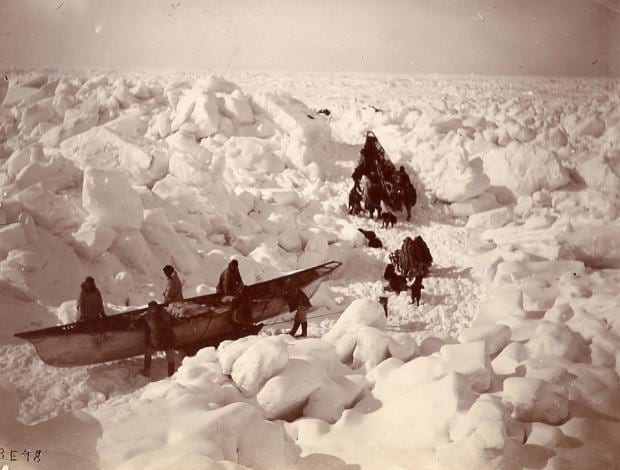
Search the online database for images in the collection. Click on SEARCH PHOTOGRAPHS, then SEARCH. On the top of the page, type “Jarvis” in the KEYWORD FIELD.
Finding Aid
Kennedy Collection
The Kennedy Collection of the New Bedford Whaling Museum consists of approximately 150 photographs compiled, and primarily taken, by Charles D. Kennedy in 1886 while serving aboard the U.S. Revenue Cutter Bear in the Arctic. Photograph subjects include the Bear and her crew, Alaskan landscapes, settlements, and vessels encountered by the Bear.
Little biographical information is available for Charles D. Kennedy. Kennedy joined the United States Revenue Cutter Service as a cadet in 1880. He was made a third lieutenant in July of 1882 and a second lieutenant in February of 1888. Kennedy resigned from the Revenue Cutter Service in May of 1888. The photographs in the Kennedy Collection were taken in 1886, when Kennedy was stationed aboard the Bear, a cutter based in San Francisco that cruised off Alaska in the Bering Sea and the Arctic Ocean. In addition to the Bear, Kennedy served aboard the bark Chase based in New Bedford, the steamer Dexter based in Newport, the steamer Rush based in Alaska, and the steamer Wolcott based in Port Townsend, Washington.
There are four images in the Kennedy Collection that were not taken by Lieutenant Kennedy: a photograph of Gideon Nye Bartlett in Arctic costume, a photograph of the whaling bark Thomas Pope, a photograph of the whaling steamer Belvidere, and a photograph by C.J.K of the bark Legal Tender. All of these photographs were taken in 1878, long before Kennedy’s first trip to the Arctic. It is not known when Kennedy acquired these photographs.
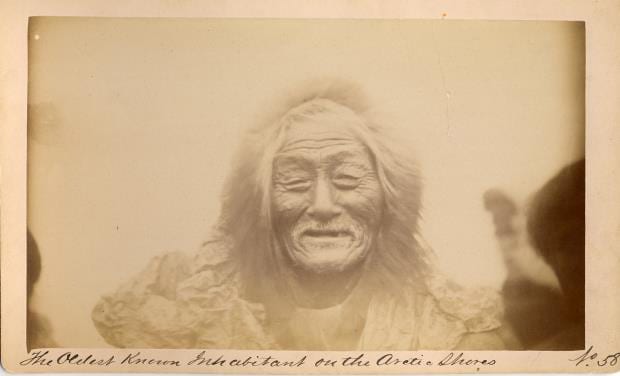
Search the online database for images in the collection. Click on SEARCH PHOTOGRAPHS, then SEARCH. On the top of the page, type “Kennedy” in the KEYWORD FIELD.

